
In Greek mythology, Agamemnon was a king of Mycenae who commanded the Achaeans during the Trojan War. He was the son of King Atreus and Queen Aerope, the brother of Menelaus, the husband of Clytemnestra, and the father of Iphigenia, Iphianassa, Electra, Laodike, Orestes and Chrysothemis. Legends make him the king of Mycenae or Argos, thought to be different names for the same area. Agamemnon was killed upon his return from Troy by Clytemnestra, or in an older version of the story, by Clytemnestra's lover Aegisthus.

In Greek mythology, Hector is a Trojan prince, and a hero and the greatest warrior for Troy during the Trojan War. He is a major character in Homer's Iliad, where he leads the Trojans and their allies in the defense of Troy, killing countless Greek warriors. However, he is ultimately killed in single combat by the Greek hero Achilles, who later drags his dead body around the city of Troy behind his chariot.

In Greek mythology, Priam was the legendary and last king of Troy during the Trojan War. He was the son of Laomedon. His many children included notable characters such as Hector, Paris, and Cassandra.

The Trojan War was a legendary conflict in Greek mythology that took place around the 12th or 13th century BCE. The war was waged by the Achaeans (Greeks) against the city of Troy after Paris of Troy took Helen from her husband Menelaus, king of Sparta. The war is one of the most important events in Greek mythology, and it has been narrated through many works of Greek literature, most notably Homer's Iliad. The core of the Iliad describes a period of four days and two nights in the tenth year of the decade-long siege of Troy; the Odyssey describes the journey home of Odysseus, one of the war's heroes. Other parts of the war are described in a cycle of epic poems, which have survived through fragments. Episodes from the war provided material for Greek tragedy and other works of Greek literature, and for Roman poets including Virgil and Ovid.

In Greek mythology, Menelaus was a Greek king of Mycenaean (pre-Dorian) Sparta. According to the Iliad, the Trojan war began as a result of Menelaus’s wife, Helen, fleeing to Troy with the Trojan prince Paris. Menelaus was a central figure in the Trojan War, leading the Spartan contingent of the Greek army, under his elder brother Agamemnon, king of Mycenae. Prominent in both the Iliad and Odyssey, Menelaus was also popular in Greek vase painting and Greek tragedy, the latter more as a hero of the Trojan War than as a member of the doomed House of Atreus.
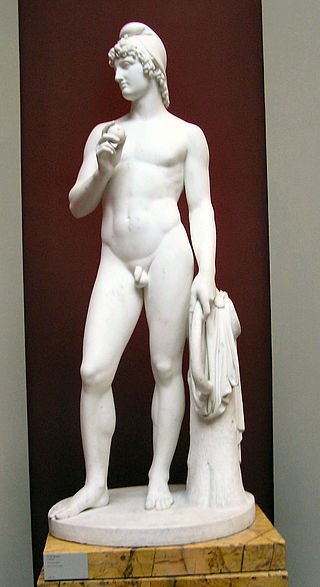
Paris, also known as Alexander, is a mythological figure in the story of the Trojan War. He appears in numerous Greek legends and works of Ancient Greek literature such as the Iliad. In myth, he is prince of Troy, son of King Priam and Queen Hecuba, and younger brother of Prince Hector. His elopement with Helen sparks the Trojan War, during which he fatally wounds Achilles.

Helen, also known as Helen of Troy, in Latin as Helena, beautiful Helen, Helen of Argos, or Helen of Sparta, was a figure in Greek mythology said to have been the most beautiful woman in the world. She was believed to have been the daughter of Zeus and Leda, and was the sister of Clytemnestra, Castor and Pollux, Philonoe, Phoebe and Timandra. She was married to King Menelaus of Sparta "who became by her the father of Hermione, and, according to others, of Nicostratus also." Her abduction by Paris of Troy was the most immediate cause of the Trojan War.
In Greek mythology, Deiphobus was a son of Priam and Hecuba. He was a prince of Troy, and the greatest of Priam's sons after Hector and Paris. Deiphobus killed four men of fame in the Trojan War.

Troy is a 2004 epic historical war film directed by Wolfgang Petersen and written by David Benioff. Produced by units in Malta, Mexico and Britain's Shepperton Studios, the film features an ensemble cast led by Brad Pitt, Eric Bana, Sean Bean, Brian Cox, Brendan Gleeson and Orlando Bloom. It is loosely based on Homer's Iliad in its narration of the entire story of the decade-long Trojan War—condensed into little more than a couple of weeks, rather than just the quarrel between Achilles and Agamemnon in the ninth year. Achilles leads his Myrmidons along with the rest of the Greek army invading the historical city of Troy, defended by Hector's Trojan army. The end of the film is not taken from the Iliad, but rather from Quintus Smyrnaeus's Posthomerica, as the Iliad concludes with Hector's death and funeral.
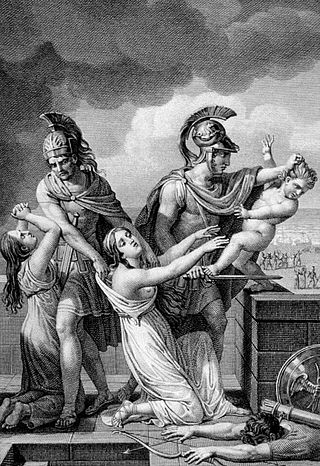
The Trojan Women, also translated as The Women of Troy, and also known by its transliterated Greek title Troades, is a tragedy by the Greek playwright Euripides. Produced in 415 BC during the Peloponnesian War, it is often considered a commentary on the capture of the Aegean island of Melos and the subsequent slaughter and subjugation of its populace by the Athenians earlier that year (see History of Milos). 415 BC was also the year of the scandalous desecration of the hermai and the launch of the Athenians' second expedition to Sicily, events which may also have influenced the author.
Paris is a rock musical written by Australian rock musician Jon English and David Mackay between 1987 and 1990, based on the myth of the Trojan War. A concept album was released in Australia in 1990 with the first stage production taking place in Sydney in 2003.
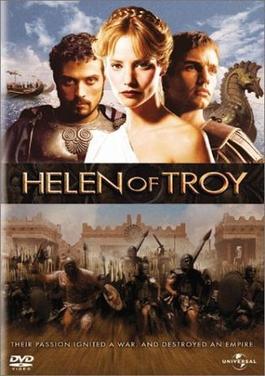
Helen of Troy is a 2003 British-American television miniseries based upon Homer's story of the Trojan War, as recounted in the epic poem, the Iliad.

Troy is a young adult novel by Adèle Geras, published in 2000. It is based on events in The Iliad, incorporating original stories set in the heart of the city towards the end of the Trojan War. The novel was shortlisted for the Carnegie Medal, the Whitbread Award and the Guardian Award.

The Iliad is one of two major ancient Greek epic poems attributed to Homer. It is one of the oldest extant works of literature still widely read by modern audiences. As with the Odyssey, the poem is divided into 24 books and was written in dactylic hexameter. It contains 15,693 lines in its most widely accepted version. Set towards the end of the Trojan War, a ten-year siege of the city of Troy by a coalition of Mycenaean Greek states, the poem depicts significant events in the siege's final weeks. In particular, it depicts a fierce quarrel between King Agamemnon and a celebrated warrior, Achilles. It is a central part of the Epic Cycle. The Iliad is often regarded as the first substantial piece of European literature.
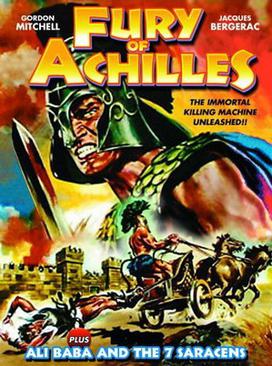
L'ira di Achille, internationally released as The Fury of Achilles, is a 1962 Italian historical drama set in the ninth year of the Trojan War and is based primarily on Homer's Iliad. The film was directed by Marino Girolami and starred Gordon Mitchell as Achilles. It was released in the UK in 1963 as ACHILLES and was filmed in EuroScope and Eastman Color.
Greek mythology has consistently served as a source for many filmmakers due to its artistic appeal. Antiquity has been reimagined in many ways and these recreations have been met with great public success regardless of their individual achievements. The plot lines of epic poetry are even more appealing with their enthralling battles, heroic characters, monsters, and gods. And now, with modern technology and computer-generated imagery (CGI), our ability as a society to recreate Greek mythology on screen has improved greatly.
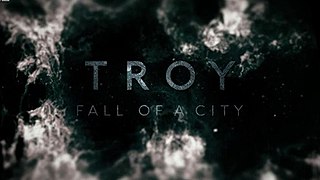
Troy: Fall of a City is a British-American historical drama television miniseries based on the Trojan War and the love affair between Paris and Helen. The show tells the story of the 10-year siege of Troy, set in the 13th century BC. It is not an adaptation of Homer's Iliad or Odyssey but rather an original take on the Greek myths, and covers some ground only alluded to in those works. The series was commissioned by BBC One and is a co-production between BBC One and Netflix, with BBC One airing the show on 17 February 2018 in the United Kingdom, and Netflix streaming the show internationally outside the UK.

The Fall of Troy is a 1911 Italian silent short film directed by Giovanni Pastrone and Luigi Romano Borgnetto. It is the first known cinematographic adaptation of Homer's epic poem, the Iliad.
Troy is an opera in two acts by Bujor Hoinic set to a Turkish-language libretto by Artun Hoinic, based on the ancient Greek epic poem Iliad by Homer. It premiered in Ankara, Turkey, in 2018 and was restaged at Bolshoi Theatre in Moscow, Russia, in 2019.















